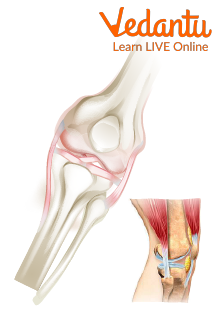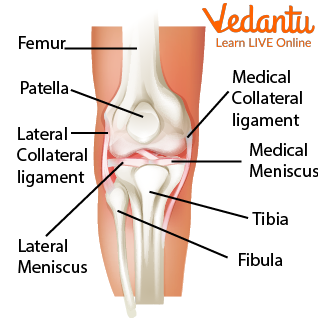




A Brief Introduction to Ligaments and Bone Joints
Your joints' ligaments are bands of strong, elastic tissue. They bind bones together, support your joints, and restrict joint mobility. Your elbows, shoulders, knees, and other joints are all surrounded by ligaments. Your joints may become unstable when you stretch or tear them. A ligament in the human body is a strong, fibrous band of connective tissue that supports internal organs and keeps bones properly aligned at joints.
The fibrous bundles of collagenous fibres and fibrocytes, spindle-shaped cells with little ground material, make up a ligament (a gel-like component of the various connective tissues). Let’s figure out what ligaments are. In joints, ligaments in the human body create a capsular sac to house the articulating bone to bone joint ends and the synovial membrane, which serves as a lubricant.
A bursa is a pouch or recess that occasionally lines a structure with synovial tissue.

Ligaments in Joints
How many Ligaments are there in the Human Body and their Location?
Your body has more than 900 ligaments in all. Your arms and legs contain the majority of them. Ligaments resemble cords and are constructed from connective tissue, elastic fibres, and collagen, a protein that holds together tissues in mammals. Ligaments exist in a variety of sizes and forms. Most resemble bands, cords, or ropes. Others are broader while others are thin, like a strand of string. Some even have an arch form. They might be white, pink, or yellow.
A sprain, also known as an overstretch or ruptured ligament, can occur. Sprains are a frequent ailment, but there are certain preventative measures you can take to keep your ligaments stronger and safer.
Bone Joint
The points where two or more bones touch are called bone joints. The bones may move since the majority of joints are flexible. The following are the components of joints
Cartilage - This kind of tissue covers the bone's surface when a joint is present. The friction of movement within a joint is lessened by cartilage.
Synovial Lining - The synovial membrane, a kind of tissue, lines the joint and creates a joint capsule. To lubricate the joint, the synovial membrane secretes synovial fluid, a transparent, gooey substance.
Ligaments - To provide support and restrict joint mobility, strong ligaments (stiff, elastic bands of connective tissue) surround the joint. A bone joint happens to be secured by a ligament.
Tendons - On either side of a joint, muscles that regulate the movement of the joint are connected by tendons, another form of hard connective tissue. Tendons link bones and muscles.
Largest Joint in the Human Body
The place where bones of the lower and upper legs converge is the knee. The knee, which is the largest joint in the human body, allows you to sit, squat, walk, and leap because it moves like a hinge. Three bones make up the knee: the femur, often known as the thigh bone or upper leg bone.

The Human Knee and the Importance of Joint
Summary
Ligaments provide several crucial functions that aid in appropriate movement. They permit the joint to move in the direction or directions that it was designed to, bind bones together, ensure that no joints twist, stabilise the bones and muscles, bolster joints, and prevent the dislocation of bones. The area of the body where two or more bones unite to allow for movement is known as a joint. In general, the wider the range of motion, the greater the danger of damage since the joint's strength is diminished. Ball and socket, saddle, hinge, condyloid, pivot, and gliding are among the six varieties of freely moveable with the help of bone-to-bone joints.
FAQs on What are Ligaments in the Human Body?
1. Name the different types of joints.
There are many different kinds of joints, including those that adults cannot move, such as the suture joints in the skull. Fixed joints are those that are immobile. The vertebrae and other joints may make a little movement. The following list includes examples of movable joints:
Joints with a Ball and Socket - Backward, forward, sideways, and rotational movements are all possible with ball-and-socket joints, such as the hip and shoulder joints.
Joint Hinges - The only motions permitted by hinge joints, which are found in the fingers, knees, elbows, and toes, are bending and straightening.
Joint Pivots - Limited rotational motions are permitted by pivot joints, such as the neck joints.
2. What do you mean by bone joint and the biggest bone joint?
We have joints in our bodies wherever two or more bones meet. The human body has 250 to 350 joints. These joints vary in how visible they are. In most circumstances, joints allow for mobility in addition to mechanical support. The knee is the biggest joint in the body. It joins the lower leg's femur to the upper leg (tibia and fibula).
3. Name the smallest bone joint in the human body.
The smallest bone joint is situated in the middle ear, between the bones.
4. Are all ligaments in the human body the same?
No. All ligaments present in the human body are not the same. Certain ligaments are rich in elastic fibres that are fairly tough while yet allowing for elastic movement, other ligaments are rich in collagenous fibres, which are strong and inelastic.
5. What is a bursa?
A bursa is a pouch or recess that occasionally lines a structure with synovial tissue.









